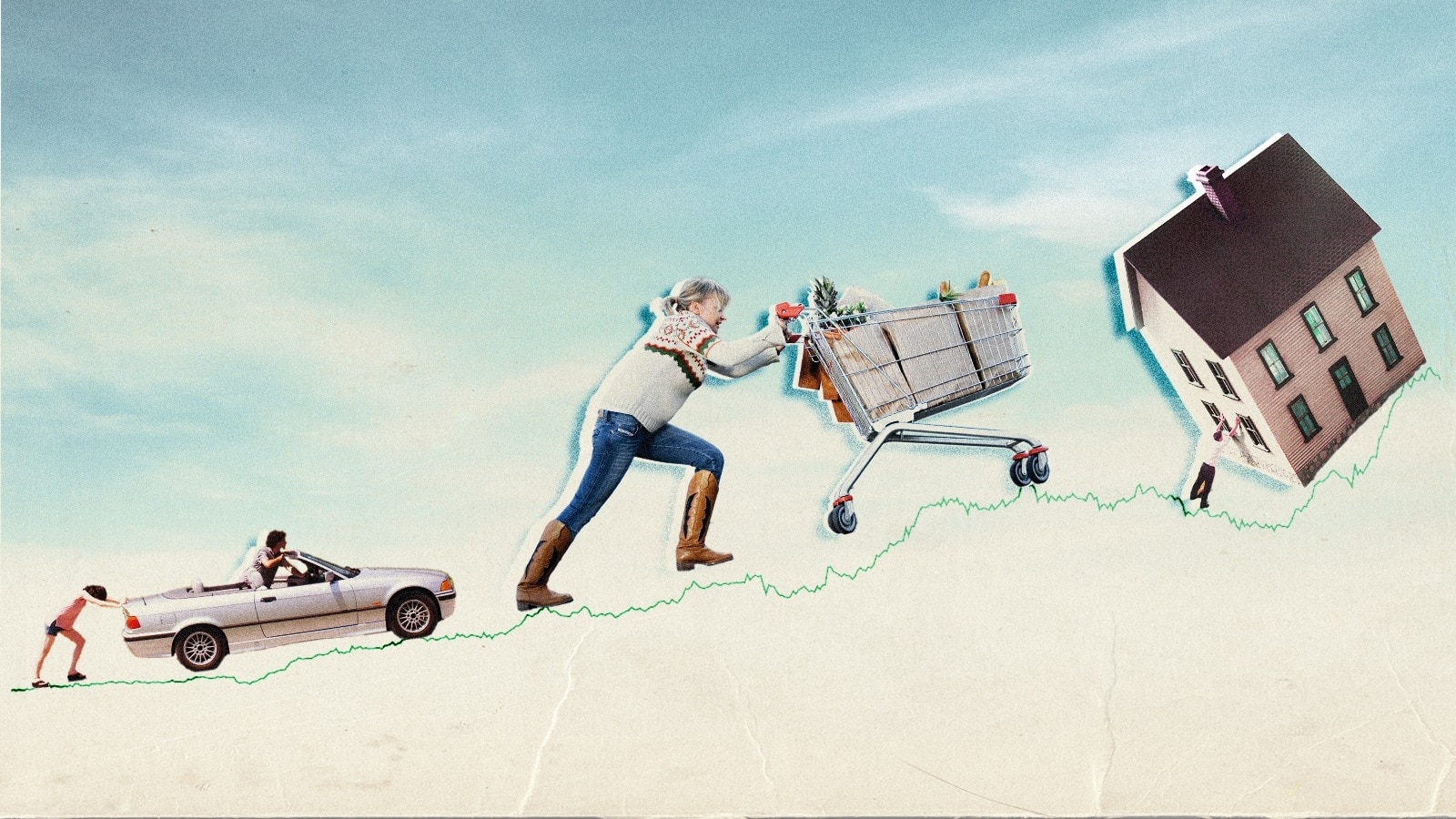The measures they use to say the economy is ‘good’ have one thing in common: they fail to account for value whatsoever.
They account for value in dollars, that’s true. But they fail to account for value in any sense that matters: the usefulness of a product or service on the one hand and the labor that produces it on the other. Instead, we look at wages, employment rates, profits, and prices. Those are admittedly easy to quantify and play around with, but they aren’t really anchored to anything meaningful.
For example, let’s say your company makes on-the-go smoothies, sold in grocery stores and convenience stores. You’ve got a quality product: a relatively thick smoothy with quality ingredients and a good variety of purees and juices. You product isn’t cheap, but that’s because you use quality ingredients, pay your employees a fair wage, and use reasonable labor practices in your bottling plant. As a result, people love your product and enjoy working for your company. Soon you come to take up a prominent position on shelves, because your regular customers will reliably buy up your stock.
Now let’s say you do an IPO. Once the board members have sway, they want to iron out some of these ‘inefficiencies’ in your company to increase their profits. First, they come for the ingredients. You wind up with fewer purees in smaller proportions, a greater proportion of inexpensive juices, and the most expensive ingredients dropping off the list entirely. Your loyal customers are annoyed that their smoothies aren’t as thick, but it’s still better than the other options, so they keep coming.
At your bottling plant, wages start to stagnate. Benefits aren’t eliminated, but a new management technique is introduced in which hours are spread out to make it difficult to meet the minimum to qualify. Shifts begin increasingly running on skeleton crews as hours are spread thinner. Of course, the same amount of work still needs to be done, so the employees are doing two to three times as much work as they used to.
Long-term employees who once made the company what it was start to see the change and look for other options before things get worse, leading to a fresh generation of new employees with no clue how much better the company used to be.
At the end your profits are up, employment is up, and you’re selling just as much or nearly as much of your product as you were before. If you only look at the numbers, it seems like this whole endeavor was a fantastic win for your company.
Except you’ve just made the world a little worse. The market presence you earned with your high-quality product no longer has an equivalent product taking it up, degrading the real value of the market itself. Employees are running themselves ragged making a perhaps flat or slightly rising wage per hour, but a wage that’s actively diminishing in terms of the labor required to earn it and the purchasing power it comes with.
Now what happens when you take this model and project it to the entire economy?
All the numbers say record profits, low unemployment, stocked shelves full of high-demand products. And yet the reality is that we have to work more to pay for less of shittier and shittier products. Even the people who win don’t really win, because they make a worse world for themselves where they can’t get a good smoothy.
The whole thing is a mirage that we’ve been killing our society chasing.
Your description of a drink that takes the world by storm, increasing in market share but dropping in quality may be roughly accurate analogy for a lot of consumer goods, but even in this telling the market is improving if that drink is displacing even lower-quality competition.
In terms of non-alcoholic drinks sold in coolers in convenience stores and grocery stores, we’ve seen the steady march of improving products as an average across the shelves, even if the same product name might be getting worse. In the 80’s, the dominant market share for orange juice in grocery stores was frozen cans to be mixed with water at home. But Tropicana and Florida Natural and a few other brands made a splash with not-from-concentrate orange juice. Old brands like Minute Maid got in on the action, and new brands like Simply rose up, too.
Now, it might be that these brands have gotten cheap with stuff since dominating market share. But if you look at who they took that market share from, it’s unquestionably a lower quality product they’ve displaced.
Across the beverage industry as a whole, you’ve got a whole bunch of newer higher priced drinks, where the unfathomably expensive for 2000 Red Bull is basically the middle of the pack for energy drinks, and where there are so many beverages that cost several times as much as Coca Cola.
So that’s a story of a forward march in higher prices for qualitatively preferred items, over that amount of time. This story I do think applies to processed food and drink, as well as electronics, prepared food, home furnishings, and cars. We expect a lot higher quality every year, as the things get more expensive, and we feel annoyed that any particular brand or model seems to be slipping in quality while we as a consumer market tend to move up the chain.
We’re angry that streaming seems to be slipping back to cable-like quality, when streaming as of 2024 is still a much better value proposition than cable in 2014. The displacement is happening in two directions, for a net benefit to the consumer in a way that doesn’t feel like a benefit. Same with music, video games, etc.
The real story is that housing, education, healthcare, and dependent care (both childcare and elder care) have gone up so much faster than inflation that these things are finally squeezing normal people out of their comfort zones right when the other stuff stopped dropping in price as much as before.
The GDP is completely irrelevant to the vast majority of people. The difference between perception of economic barometers like this one is that people used to have more faith in capitalism and it has become so painfully clear that this faith is unwarranted. In the past, people in desperate financial situations could easily delude themselves that they were temporarily embarassed while everyone else in the same situation was probably just lazy. Now people are starting to realize the system is causing it and are much less willing to eat the table scraps thrown to them during times of “economic prosperity.”
Basically, people are more aware of how they, personally, are affected by the economy.
The economy in general is doing better, but the majority of citizens are able to apply less and less of that to the things they value, and they see more and more of it being funnelled to the already wealthy.
We know by now that the economy doing well won’t translate into helping us. And any minor benefits we do see will then be hoovered up by landlords, businesses that gatekeep essential goods, and legally-required expenditures like insurance, before we even have any chance to decide for ourselves how to allocate it.
“Hey, SF raised minimum wages by 2.50? Great! That means I can bump the rent on my non rent-controlled properties by a couple hundred bucks next lease! Thanks, SF!”
No matter how you slice it, there’s a gap between how the economy is doing and how Americans feel about it.
Why do they keep insisting that we are the ones that are wrong? The economy isn’t their numbers. The economy is a real thing, proper operation of which ensures well fed people.
The purpose of an economy is to fond optimal distribution of resources for people. Ultimately it’s people that need all the things, right? Either things are materials to produce things for people, or products useful to help other products reach people.
If the people think that’s not working, it isn’t working. They’re not just parroting what they see on the news, they’re living day by day, minute by minute in this environment. They see what day to day life costs for them. They’re wrong but the eggheads tracking the over fitted model are right? When a measure becomes a goal it ceases to be a good measure, that’s where the disconnect is. If you want to fix the economy then quit pretending your metrics are more important than people’s standard of living.
I think it is more writing to people for whom that is the case.
The economy is shifting to a set of haves and have-nots. The problems that the haves deal with are tied a lot more to economic performance than have-nots.
You also have a case where unemployment is still low, with a lot of the issue being tied to low minimum wages. Usually, the problems that have-nots have with the economy have been tied to unemployment. You can get a job in this economy, it just won’t be well paying.
Someone shared this with me years ago and I find it increasingly helpful in remembering how much bullshit our economies are built upon.
Link to the Financial Times here - “The parable of the ox” by John Kay





